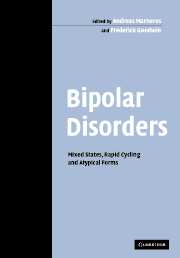Crossref Citations
This Book has been
cited by the following publications. This list is generated based on data provided by Crossref.
Röttig, S.
Brieger, P.
Wenzel, A.
and
Marneros, A.
2004.
Universitätskolloquien zur Schizophrenie.
p.
285.
Marneros, Andreas
and
Pillmann, Frank
2004.
Acute and Transient Psychoses.
Marneros, A.
2006.
Aktuelle Aspekte der Pathogenese und Therapie der Schizophrenie.
p.
21.
Pandarakalam, James Paul
2007.
Clinical challenges of bipolar depression.
British Journal of Hospital Medicine,
Vol. 68,
Issue. 10,
p.
530.
Marneros, A.
2007.
Gemischt-affektive Störungen.
Der Nervenarzt,
Vol. 78,
Issue. 1,
p.
15.
Marneros, A.
2008.
Psychiatrie und Psychotherapie.
p.
1359.
2009.
Der psychiatrische Notfall.
p.
99.
Marneros, Andreas
2009.
Bipolar Depression: Molecular Neurobiology, Clinical Diagnosis and Pharmacotherapy.
p.
3.
Jäger, M.
Becker, T.
Weinmann, S.
and
Frasch, K.
2010.
Treatment of schizoaffective disorder – a challenge for evidence‐based psychiatry.
Acta Psychiatrica Scandinavica,
Vol. 121,
Issue. 1,
p.
22.
Marneros, A.
2011.
Psychiatrie, Psychosomatik, Psychotherapie.
p.
1530.
Marneros, Andreas
2012.
Schizoaffective Disorder.
Korean Journal of Schizophrenia Research,
Vol. 15,
Issue. 1,
p.
5.
Jauhar, Sameer
and
Cavanagh, Jonathan
2013.
The Wiley‐Blackwell Handbook of Mood Disorders.
p.
289.
Brieger, Peter
Marneros, Andreas
and
Jäger, Markus
2015.
Psychiatrie, Psychosomatik, Psychotherapie.
p.
1.
Fornaro, Michele
Stubbs, Brendon
De Berardis, Domenico
Perna, Giampaolo
Valchera, Alessandro
Veronese, Nicola
Solmi, Marco
and
Ganança, Licínia
2016.
Atypical Antipsychotics in the Treatment of Acute Bipolar Depression with Mixed Features: A Systematic Review and Exploratory Meta-Analysis of Placebo-Controlled Clinical Trials.
International Journal of Molecular Sciences,
Vol. 17,
Issue. 2,
p.
241.
Brieger, Peter
Marneros, Andreas
and
Jäger, Markus
2017.
Psychiatrie, Psychosomatik, Psychotherapie.
p.
1675.
Solé, Eva
Garriga, Marina
Valentí, Marc
and
Vieta, Eduard
2017.
Mixed features in bipolar disorder.
CNS Spectrums,
Vol. 22,
Issue. 2,
p.
134.
McIntyre, Roger S.
Young, Allan H.
and
Haddad, Peter M.
2018.
Rethinking the spectrum of mood disorders: implications for diagnosis and management – Proceedings of a symposium presented at the 30th Annual European College of Neuropsychopharmacology Congress, 4 September 2017, Paris, France.
Therapeutic Advances in Psychopharmacology,
Vol. 8,
Issue. 1_suppl,
p.
1.
López‐Díaz, Á.
Fernández‐González, J. L.
Lara, I.
Crespo‐Facorro, B.
and
Ruiz‐Veguilla, M.
2019.
The prognostic role of catatonia, hallucinations, and symptoms of schizophrenia in acute and transient psychosis.
Acta Psychiatrica Scandinavica,
Vol. 140,
Issue. 6,
p.
574.
Burgess, Jennifer
Currie, Alan
Watson, Stuart
Sharma, Aditya
Cousins, David
Cookson, John
and
McAllister-Williams, R. Hamish
2024.
Seminars in General Adult Psychiatry.
p.
162.



